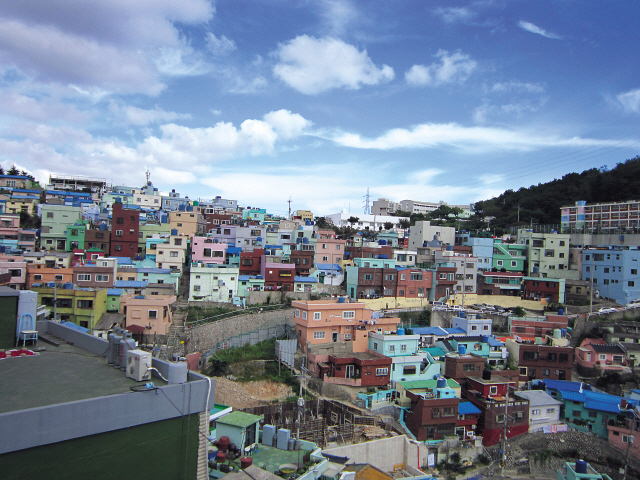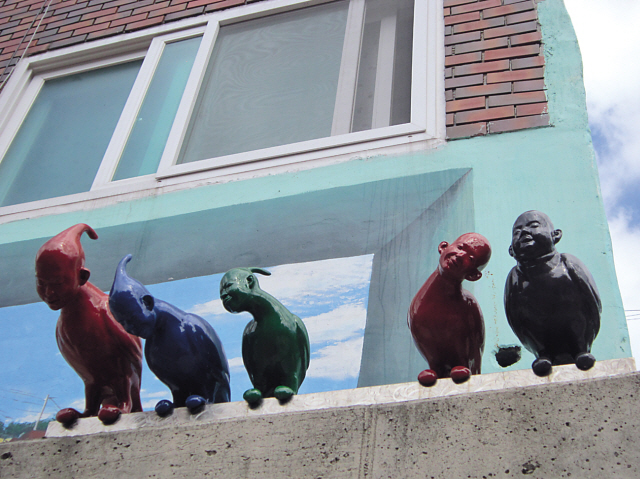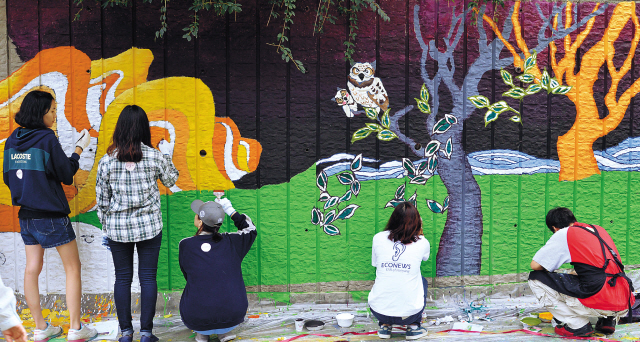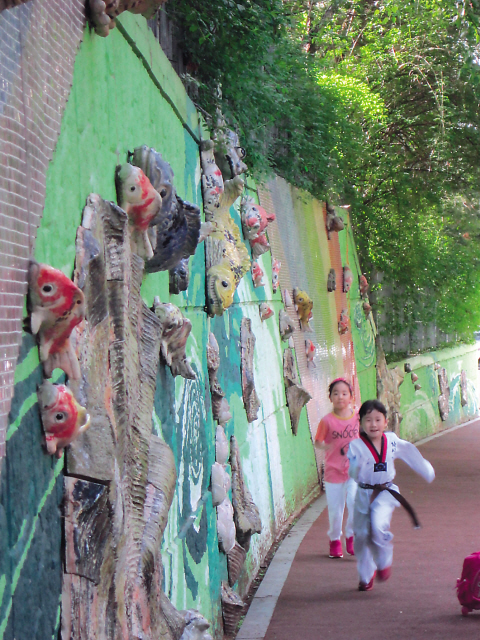Home is where the art is
Murals revitalize once run-down neighborhoods, attract visitors
By Korea HeraldPublished : May 24, 2013 - 20:51

The Gamcheon area of Busan used to be somewhere people would usually avoid. Seen as a ghetto, the place held little charm.
But in 2009 things started to change. Artists and activists gathered at this little-known place, painted the walls and installed art here, there and everywhere.
Annual projects such as “MiroMiro Alley” and “Sanbok Road Renaissance” turned the rough grey walls pink, blue, yellow and other pastel shades, while stairways and outdated facilities were given a facelift. At street corners are humorous murals or installation art pieces that make even the most taciturn of people smile.
People now call the place the “Santorini of Korea.” It received a 2012 UN-HABITAT Asian Townscape Award. More than 98,000 people visited the mountainside area last year and double the figure is expected to flock there this year. The administrators and residents have adopted stamps for tourists to collect while new cafes, art shops and art galleries are springing up.
But in 2009 things started to change. Artists and activists gathered at this little-known place, painted the walls and installed art here, there and everywhere.
Annual projects such as “MiroMiro Alley” and “Sanbok Road Renaissance” turned the rough grey walls pink, blue, yellow and other pastel shades, while stairways and outdated facilities were given a facelift. At street corners are humorous murals or installation art pieces that make even the most taciturn of people smile.
People now call the place the “Santorini of Korea.” It received a 2012 UN-HABITAT Asian Townscape Award. More than 98,000 people visited the mountainside area last year and double the figure is expected to flock there this year. The administrators and residents have adopted stamps for tourists to collect while new cafes, art shops and art galleries are springing up.

But perhaps the most important change came from within the villagers. Instead of locking up their doors and hearts, they are opening up and welcoming the change.
“It used to be an outdated place but the paintings have definitely brought a new lease of life to the village,” said a volunteer at the village’s library at the top of the hill, who declined to be named. Trash bags that used to lie around everywhere have disappeared and people are cleaning up the alleys and roads every day. “We are happy to be accepted as part of society,” she added.
As the case of Gamcheon illustrates, art has become a driving force for improving rundown city areas and their largely alienated communities. With the participation of more “socially-conscious” artists and administrators, these neighborhoods are rapidly being transformed into tourist sights

Improving the neighborhood
Mullae-dong in western Seoul is dotted with small metal works. With minute iron particles floating in the air and the sound of the grinding and welding filling your ears, the place was not the best place to enjoy a Sunday afternoon, until small groups of artists began to take up residence at empty metal works.
The artists formed a small community of their own and started inviting over their neighbors. They started drawing flowers, trees and picturesque images or cartoons on the walls of the district or shutters of the shops.
“When all the stores and foundries closed, this area was a bit scary. But with all the paintings I feel somehow much safer hanging around here,” said Kim Soo-yeong, a 27-year-old office worker who has visited the place several times. The area has become a favorite haunt for amateur photographers.
“We have a lot of people coming over here. Unless they infringe upon our privacy, I welcome them. They make our lives more vibrant,” a resident said.
Mullae-dong in western Seoul is dotted with small metal works. With minute iron particles floating in the air and the sound of the grinding and welding filling your ears, the place was not the best place to enjoy a Sunday afternoon, until small groups of artists began to take up residence at empty metal works.
The artists formed a small community of their own and started inviting over their neighbors. They started drawing flowers, trees and picturesque images or cartoons on the walls of the district or shutters of the shops.
“When all the stores and foundries closed, this area was a bit scary. But with all the paintings I feel somehow much safer hanging around here,” said Kim Soo-yeong, a 27-year-old office worker who has visited the place several times. The area has become a favorite haunt for amateur photographers.
“We have a lot of people coming over here. Unless they infringe upon our privacy, I welcome them. They make our lives more vibrant,” a resident said.

Consoling the neighbors
An alley near Kyung Hee University in northern Seoul is named “Mural Alley” for its reportedly more than 200 paintings on the walls. From John Lennon to a Korean War orphan, the pictures were created by art students of the university. They often portray harsh realities ― pictures of a man growing into a greedy, fat person and then into a pig; students suffering from student loans right after graduation and others are depicted on the wall next to the “revolution of sex” and other socially-controversial messages.
Painting the mural has become part of the regular curriculum at the university after the first experiment in 2009 received a positive response. Last year, the local authorities joined hands to help the pilot project become a regular thing.
“We wanted to cheer up our friends ― and it is going to be our future, too,” said an art student, who has participated in the project. “This area is always filled with students and if they come across our pieces and find a bit of solace, it’s mission accomplished,” she said.
Other popular mural areas:
- Hongdae Mural Street: A cluster of alleys near Hongik University, where murals, paintings on the floor and artwork by Hongik University students greet visitors. To get there, leave Hongik University Station Exit 8 and turn right, and then take the second right into a wide street with little vehicular traffic.
- Sunae Mural: Using ceramics, local artists have added a 3-D effect to the 86 meter-long, 3.2 meter-tall wall in front of the Sunae 3-dong Community Center in Bundang, Gyeonggi Province. Take either the Bundang or Shin Bundang line, leave at Jeongja Station, take 190-1 bus and leave at Dongguk University Hanbang Byeongwon (Oriental Medical Clinic) and cross the street.
- Ihwa Mural Village: From Hyehwa Station Exit 1, turn back and walk straight until you see Naksan Park, which is the starting point of the mural village with dozens of paintings on the walls by local artists.
- Gaemi Maeul: From Hongje Station Exit 2. Take bus No. 7 to the last destination, which is the starting point of the village with shacks decorated with various murals. The place was named the Human City Olle (trail) by the Human City Consensus in 2012.
- Dongpirang Village in Tongyeong, South Gyeongsang Province: The village is filled with small paintings, which go well with the panoramic view of the ocean in front of it. Take any bus to Jungang Market then walk toward the Citizen’s Center until you find a small alley with a sunflower mural. It is the starting point of the almost-destroyed village turned into a brightly colored tourist attraction.
- Goso-dong Angelic Mural Alley in Yeosu, South Jeolla Province: From the Marine Park across Goso-dong, about 1 kilometer of walls are painted with images about the ocean, marine life and other themes. The murals were painted with a fund created by local residents. Take any bus to Samyangsa Temple. Look for Bada Supermarket, proceed for about 10 meters then turn left and walk another 50-80 meters till you get to the entrance.
By Bae Ji-sook (baejisook@heraldcorp.com)
-
Articles by Korea Herald





![[From the Scene] Monks, Buddhists hail return of remains of Buddhas](http://res.heraldm.com/phpwas/restmb_idxmake.php?idx=644&simg=/content/image/2024/04/19/20240419050617_0.jpg&u=20240419175937)




![[Graphic News] French bulldog most popular breed in US, Maltese most popular in Korea](http://res.heraldm.com/phpwas/restmb_idxmake.php?idx=644&simg=/content/image/2024/04/18/20240418050864_0.gif&u=)




![[From the Scene] Monks, Buddhists hail return of remains of Buddhas](http://res.heraldm.com/phpwas/restmb_idxmake.php?idx=652&simg=/content/image/2024/04/19/20240419050617_0.jpg&u=20240419175937)

![[KH Explains] Hyundai's full hybrid edge to pay off amid slow transition to pure EVs](http://res.heraldm.com/phpwas/restmb_idxmake.php?idx=652&simg=/content/image/2024/04/18/20240418050645_0.jpg&u=20240419100350)

![[Today’s K-pop] Illit drops debut single remix](http://res.heraldm.com/phpwas/restmb_idxmake.php?idx=642&simg=/content/image/2024/04/19/20240419050612_0.jpg&u=)